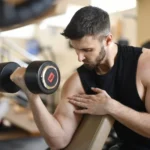For all the good reasons, the inclined barbell press is the mainstay of chest days. This exercise activates the muscles in your back, triceps, shoulders, and chest.
Increasing the effort required from your shoulders and moving tension to your upper chest fibers, and changing your pressing angle can maximize the advantages of this exercise.
The inclined barbell press is a beneficial training tool, despite the fact that the flat bench version is a powerlifter’s go-to exercise for the upper body.
Strongmen and strongwomen frequently enjoy using the inclined as a secret approach to add additional shoulder work for log presses.
In order to develop a full chest, bodybuilders incorporate inclined barbell presses into their routines.
| You may also like to read: |
How to Do the Inclined Barbell Press?
Here is a step-by-step guide on how to do an inclined barbell press.
Step 1: Establish Your Base
Set the angle of an inclined exercise bench between 30 and 45 degrees. Remain relaxed on the seat.
Place your upper back and hips on the bench and firmly place your feet on the ground. Now, actively press your knees out.
Your glutes and quadriceps will be worked out, as a result, enabling you to lift the weight off of your chest.
Step 2: Establish Grip
Each person has a different spot where their hands rest comfortably on the bar. Your hands, however, may typically be a little wider than shoulder-width.
If in doubt, check that your forearms at the bottom of the bench press are parallel to the floor. Look for the barbell’s smooth ring that rests in the knurling. Utilize that as a benchmark when assessing your grip.
Step 3: Controlled Pull Down of the Barbell
Open the barbell rack. Place support for it across your upper chest and shoulders. To accomplish this, pull your shoulder blades back firmly and crush the barbell to strengthen your hold.
Bring the barbell up to your chest. Use your back muscles consciously to prevent your shoulders and chest from hunching forward.
Actively stretch your pectoral muscles as you lower the bar. Keep your shoulders firmly placed on the bench. Moreover, avoid letting the bar rest against your chest. Bring the bar close to your chest.
Step 4: Raise the Bar
Press the bar upward while bringing your elbows inwards your body and set your elbows out. During this stage, be careful not to lose stability or control.
Maintain your shoulders firmly on the bench. Keeping your feet firmly placed on the ground and twisting them helps a lot.
| You may also like to read: |
Suggestions for better efficacy:
To increase muscle mass
If hypertrophy is your primary objective, you should train fairly heavily in the 6 to 15-repetition range. With each set, the approach fails.
Use light to heavy weight for three to five sets of 5 to 15 repetitions. A moderate load can also be used to complete two to four sets of 10 to 15 repetitions till failure. Between sets, take a 45 to 90-second break.
To Build Strength
If your focus is to build strength then, similar to most strength exercises, the inclined barbell press can be performed with heavy weights and low to moderate repetition ranges to maximize strength increases.
When using this method, you should take lengthier breaks. Use a heavy weight and perform three to five sets of 3 to 5 repetitions. Between sets, take a three to five-minute break.
| You may also like to read: |
Benefits of the Inclined Barbell Press
The barbell press engages a number of muscles simultaneously. Although the major chest muscles are the main focus, the deltoids, triceps, biceps, rhomboids, serratus anterior, and rotator cuff get a decent workout as well.
For Chest (pectorals) Muscles:
Inclined Barbell Press involves working the pectorals (chest muscles). The inclined press does, however, put more strain on the upper chest muscles because of the press’s large angle.
For Front Deltoids
The front deltoids work during an inclined barbell press. However, the front deltoids are significantly more heavily utilized during the inclined press.
Your upper chest and anterior deltoids will be your targets as you take a more vertical pressing plane. That’s how you involve your shoulders more as your press angle becomes more vertical.
For Triceps
As you perform the inclined barbell press, your triceps help to extend your elbow. That is how this technique can increase the variety of your triceps pressing power, which will ultimately improve all of your presses.
More upper chest isolation
Whether you’re resting flat or inclined, any type of bench press stimulates the pectoral muscles. The angle of your chest during the inclined bench press, however, can isolate the upper pectoral fibers more effectively.
This makes it a wonderful motion for strengthening the chest’s neglected areas and weaker ranges.
Muscle up your upper body more
The inclined barbell press can be worked on frequently and with rather heavy loads. This makes it a highly efficient lift that uses several joints to maximize muscle growth.
The sets, repetitions, and weights can be tailored according to the workout to your specific requirements.
Boost athletic performance and upper body pressing strength
The inclined barbell press allows athletes to vary their pressing strength and performance.
Athletes can frequently target trouble spots, deal with muscle deficiencies, and promote new muscular growth by changing the angles of pressing variants.
Burns fat
Incline barbell pressing can assist burn fat by promoting the development of muscle mass.
You can minimize your risk of osteoarthritis by gaining flexibility, more bone density, and more muscle in addition to higher muscle mass.
Additional Health Benefits of Incline Barbell Press:
Additionally, it helps the body digest sugar, reducing the risk of diabetes, as other activities do. Professionals generally agree that regular bench pressing can decrease “bad” cholesterol and enhance “good” cholesterol, lowering the risk of heart-related disorders.
Benefits for runners
Perhaps a surprise advantage is that bench press regulars also tend to be faster runners. This has to do with how the arms and chest are used when running, and how to bench pressing properly prepares them for running with the best form.
| You may also like to read: |
Common Mistakes when doing Incline Barbell Press workout:
Here are a few common mistakes people do while performing inclined barbell press:
- Doing an inclined barbell press with a flat back is a technical problem. As you set up, start by pulling back your scapula and keep it there during the entire lift. Otherwise, your shoulders become unstable if you skip this important phase.
- Elbow flares on the decline are a technical problem as well. While descending, tuck your elbows to about a 45-degree angle. Using this method will relieve pressure from your shoulder capsule and pectoralis tendon.
- Touching your chest too low might put too much strain on your shoulders, causing pain and damage.
Things to Be Taken Care Of
When inclined barbell pressing, there are three crucial things to keep in mind:
- Use correct form
- Have a spotter
- Don’t lift more weight than you can manage
Unfortunately, some people disregard some or all of these fundamental guidelines, which can lead to severe damage.
Tears in the pectoral muscles and injury to the rotator cuff are the two most frequent injuries from barbell pressing.
Both of these injuries have the potential to be life-threatening, necessitate surgery, and prevent you from working out for months.
Additionally, lifting too much might strain the shoulder blades, causing pain and/or inflammation that may further impede muscle growth.
At the end of a repetition, it’s fairly popular but highly dangerous to try to rack the weights or let the bar bounce off the chest.
| You may also like to read: |
Who Should Do the Inclined Barbell Bench Press?
Strongman Athletes:
An incline barbell bench press will enable them to practice all pressing motions at the most typical sporting angles.
Olympic Weightlifters:
Olympic weightlifters need strong shoulders, triceps, and chests in order to accelerate loads above their heads.
Many of the muscles required to carry out weightlifting duties are strengthened by the inclined barbell press.
Regular Gym-goers:
Although the incline barbell press is common among gymgoers it is not permitted in routine training. They will need to lift less weight than they would on a flat bench because of the angle.
Nevertheless, some lifters might not want to lower their standards. But ultimately, using the inclined barbell press can help them lift more weight off the bar because, when done correctly, it offers training variety, hits various chest muscle groups, and puts less strain on your shoulders.
| You may also like to read: |
Is Incline Barbell Press Necessary?
The Incline Bench is not really necessary. The major advantage, though, is that it gives you a pressing variation you may utilize to switch up your practice.
If you’ve been exercising for a time, you may have noticed that performing the same activities repeatedly might lead to injuries.
Alternative Incline barbell Press Exercises:
If your routine does not include an incline barbell press, you will need to find another exercise that will activate your upper chest muscles by putting them through a variety of motions.
Following are the exercises that can be done as an alternative to the incline barbell press:
- Landmine chest presses
- Standing dumbbell chest fly
- Incline Swiss Ball Dumbbell Press
- The decline push-up
- Incline cable flyes
- Dumbbell pullovers
- Reverse grip rotational dumbbell press
- Underhand front raises for chest
| You may also like to read: |




